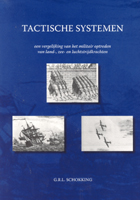An old problem in military affairs is approached here in a new way. Many soldiers and students have wondered wich are the essentials of warfare. For this they have paid attention to history. The most famous of them is Clausewitz. He has however restricted his attention to land warfare and mainly to the wars of Frederic the Great and Napoleon. In this book warfare has been studied as far as known till the Second World War. In contrast to other works is our study not confined to the war on land, at sea or in the air. The military activity in all these spheres are compared. For this a new instrument has been made, 'the axial model', derived from an analysis of an encounter.
When one tries to eliminate one's opponent it is firstly necessary to know where he is. So it needs to observe him or the place where he hides. Therefore 'observation' is the first basic element in an encounter. Next, one must be in the right distance and in a good position to take aim at him. This means often moving in his direction. Doing so there is a risk to be seen and hit by the adversary. So it is important to be mobile. Consequently 'movement' is the second element. To eliminate the opposition it is necessary to destruct the opponent's cover, his tools and mostly himself. Thus 'destruction' is the third element. In an encounter both parties score and have to take hits. The victor is not only the party who hits hart, but who is also able to take hits without qualing. In that way 'taking' is the fourth element. Not only movement but also the other three elements take place by an imaginary line and in a certain direction. These lines and directions are interpreted as an axis of movement, an axis of observation, an axis of destruction and an axis of taking. So in a phalanx with spears and shields all the four elements are coaxial. On the contrary the axis of destruction of a line of 18th century sailing ships has its line of destruction perpendicular to its axis of movement. The axis of destruction of a fighter plane is again coaxial with his axis of movement and so on.
The military events are not described individually but arranged conform their structures of relationships. By this structural approach a concise survey of a great part of military history is possible. The attention is besides focussed on tactical systems. That is to say on the standardized set of procedures prescribed for engagements. The innovations in the development of tactics are dependent of the level of technology. By means of the structural approach, of the axial model and of the development of technology, resemblances and differences, trends and change of trends in military history are to explain. Moreover the insight of the reader in warfare is improved.
|



